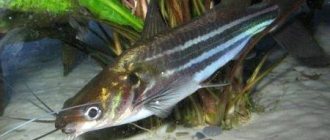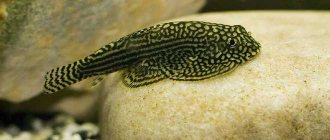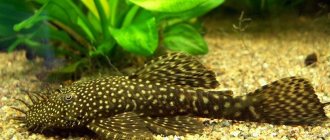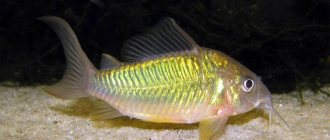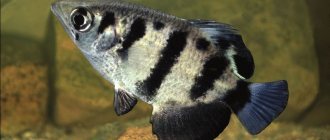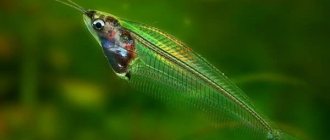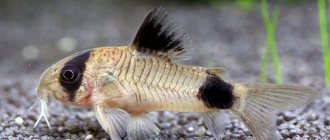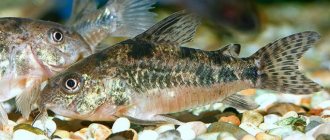The Siamese killer whale (pseudomystus siamensis, leiocassis siamensis), and not the killer whale, as is found in most searches, is a representative of the killer whale catfish family, which is found exclusively in fresh water bodies of South Asia.
In an aquarium it reaches a maximum of 12cm, in nature it can grow up to 20cm. Sexual dimorphism is weakly expressed; it is possible to distinguish a male from a female only by its smaller and more slender body.
The lifespan of the Siamese killer whale catfish (correctly Orca) is about 5-6 years.
Mystus striped catfish
Mistus striped
Mistus striped
In nature, catfish (Mystus vittatus) live in the rivers of India and Burma.
The length of the fish is up to 18 cm. It has a long body. The head is large. The predominant color of the body is silver, the upper part of the body is bluish with a violet tint. There are two thin purple stripes running along the sides. During times of stress, these stripes in fish become almost invisible. The coloration of males and females is the same, although in males it is more contrasting. The male is smaller, slimmer, and, like other killer whales, he has a special growth - the urogenital papilla.
Contents of catfish mystus: Schooling fish, active even during the day. The aquarium must be from 100 liters. for a couple of individuals. It can be decorated with a variety of plants; shelters are required. Peaceful species, but should not be kept with small fish such as neon. Filtration, aeration, weekly change of up to 1/4 of the water volume. Water parameters for keeping mistuses: hardness up to 25°, pH about 7.0, temperature 22-26 °C.
Mistus
Mystus catfish are unpretentious in feeding; they eat all types of food. Please note that feeding aquarium fish must be correct: balanced and varied. This fundamental rule is the key to successful keeping of any species of fish. Therefore, it will be useful for you to read the article “ How and how much to feed aquarium fish ,” which describes this in detail, and also outlines the basic principles of the diet and feeding regimen of the fish.
At this time, dry food is, of course, popular and popular food for fish. For example, all the time and everywhere you can find food on aquarium counters - the leader of the Russian market, which has an assortment of food “for every taste.” Tetra’s “gastronomic arsenal” includes individual food for a specific type of fish: guppies, goldfish, cichlids, loricariids, labyrinths, arowanas, discus fish, etc. Tetra has also developed specialized foods, for example, to enhance color, fortified, or for feeding fry. You can find out detailed information about all Tetra feeds on the company’s official website - here .
It would not be amiss to note that when purchasing any dry food, you should first of all pay attention to the date of its manufacture and shelf life, try not to buy food in bulk, and also store the food in a closed state - this will help to avoid the development of pathogenic flora in it .
Conditions of detention
These fish have a peaceful nature. However, sometimes they are predatory. They are nocturnal. If these fish are kept in too small aquariums, then the males may demonstrate their territoriality. Siamese killer whales usually live in the middle layers of water.
These fish need to be kept in species aquariums with a volume of 100 liters or more. They should be covered with a lid, and the lighting should be kept low. You can, of course, keep these fish in a community aquarium. But in this case, as neighbors for the Siamese Killer Whale, you need to select peace-loving and calm fish with a similar body size. It is not recommended to keep them in the same aquarium with very small fish, as well as those fish that have long fins.
You need to put driftwood and drainage tubes, stones and polyvinyl tubes in the aquarium, creating shelters and caves from them. These fish love natural plants. They are demanding about the purity of the water, so it is necessary to aerate it, replacing a third of the water weekly with settled water.
It is recommended to feed Siamese Killer Whales with live food in the form of frozen shrimp and daphnia, insects and bloodworms, and coretra. Suitable for feeding fish and dry food. It is better if these fish are eaten in the evening or at night in small portions. This is explained by the lifestyle of Siamese killer whales: they are active at night and hide from bright light during the day.
It is important to keep the water temperature under control when keeping these fish. The optimal temperature is 20-25 degrees Celsius. Hardness should be at 15°, and acidity should be up to 7.5 pH.
Siamese killer whale: content, description, photo, reproduction
The Siamese killer whale (pseudomystus siamensis, leiocassis siamensis), and not the killer whale, as is found in most searches, is a representative of the killer whale catfish family, which is found exclusively in fresh water bodies of South Asia.
In an aquarium it reaches a maximum of 12cm, in nature it can grow up to 20cm. Sexual dimorphism is weakly expressed; it is possible to distinguish a male from a female only by its smaller and more slender body.
The lifespan of the Siamese killer whale catfish (correctly Orca) is about 5-6 years.
Maintenance and care
Conditions
This type of aquarium fish loves space - an aquarium is selected from 100 liters, with greater length being preferable to height. In a large, spacious tank, the number of fights between males is minimized, which makes it possible to breed a larger number of these catfish. The aquarium should also come with a filter, a compressor and a lid (orcas are very active, playful and jumping).
The water must be clean and fresh (no salt!), its parameters: temperature 20-25°C, hardness up to 15°dH and acidity 6.5-7.5 pH. Change the water once a week, about a third of the total volume.
Soil - coarse sand, pebbles, gravel, no coral or marble chips, they are suitable only for cichlids, as they increase rigidity. Lighting is moderate, diffused, the Siamese killer whale (a killer whale is a bird, a swallow) does not like bright light and tries to hide from it in all sorts of crevices. Decorations - grottoes, broken pots, tubes in which you can hide (not too narrow or small, otherwise your pets have a good chance of getting stuck there).
Habitat
Comes from the vast basin of the Mekong River - the largest in Southeast Asia, from the territory of modern Thailand, Laos, Cambodia and Vietnam.
Inhabits slow-moving waters among flooded trees and their roots. During the daytime it stays close to shelters, and at night it comes out in search of food. Brief information:
- Aquarium volume - from 100 l.
- Temperature - 20–26°C
- pH value – 5.8–7.8
- Water hardness - from soft to hard (5–25 dGH)
- Substrate type - any soft
- Lighting - dim
- Brackish water - acceptable in a concentration of 1 teaspoon of salt per 10 liters
- Water movement is weak
- The size of the fish is up to 12 cm.
- Nutrition - protein (meat) diet
- Temperament - relatively peaceful
- Keeping alone or in a small group if shelters are available
Breeding
To breed Siamese Killer Whale, you need a spawning aquarium with a volume of at least 100 liters. In females, before spawning, the abdomen becomes significantly fuller. Usually, in preparation for spawning, pituitary injections are used, then eggs are collected manually from the female and milt from the males. Fertilization of eggs occurs artificially in a separate container. There are no facts of successful breeding of Siamese Killer Whale in an amateur aquarium yet. With professional breeding, it is possible to achieve numerous laying of eggs with a diameter of 1 mm. In this case, an important condition for spawning is an increase in temperature in the spawning area. Siamese killer whale fry are fed rotifers.
Reproduction
Unfortunately, an amateur aquarist will not be able to breed a Siamese killer whale in a home aquarium. Despite the conditions that are quite accessible to create (spawning tank - 100 liters or more, water with a temperature of 26-28 ° C and hardness up to 10 ° dH, spawning substrate, plants, imitation of the rainy season to stimulate spawning - daily replacement of part of the water with fresh water), these fish refuse to spawn without additional stimulation in the form of hormone injections.
However, even when using injections, eggs from females and milt from males have to be squeezed out manually, after which fertilization is carried out independently. The amount of caviar obtained in this way is 500-800 eggs. They ripen in an incubator at the bottom, without additional aeration, for two to three days.
The juveniles are quite large and are fed by rotifers and small plankton. Adults are considered to be individuals over the age of one year.
Mystus tengara
In my opinion, Mystus striped is undeservedly ignored by lovers of aquarium exotics. This is a very attractive fish in appearance and interesting in behavior. The white belly and stripes on the body shine with mother-of-pearl, long whiskers and winking eyes give the fish a very extravagant appearance.
Features of keeping mistuses
There is evidence that these catfish can spoil living plants by gnawing on their tender young leaves. You can try to “make friends” of catfish with plants by feeding them with plant food: lettuce leaves, scalded nettles.
Feeding mystus
Mistuses are very fond of special tablets for catfish. When I feed them to my mystus, he rushes like lightning into a pile of fish, grabs the tablet and runs away. After about five minutes he usually loses it and swims for another. These catfish are unpretentious in food, they eat absolutely everything: dry, frozen, and live food.
Water for mistuses
They require standard settled water with a temperature of about 25 degrees; it is enough to change it once every two weeks.
Breeding Mystus
You can try and breed them, but this requires stimulation of the fish using pituitary injections, which, of course, is not available to all hobbyists. Therefore, it would be better to just watch these catfish and get aesthetic pleasure from them.
general description
The correct Latin name for the species is mistus tenggara. It was studied and described at the beginning of the 19th century. Representatives of the species grow up to 45 cm in natural conditions and up to 16-25 cm in captivity. In addition to the transparent dorsal fin, they have another one - an adipose one. The fins on the chest and abdomen are small and the tail is long.
On a large head with large bulging eyes there are three pairs of whiskers. One pair grows on the upper lip, and the other two, shorter ones, extend from the lower lip. Thanks to these organs of touch, the fish feels great in the dark or thickets.
The spindle-shaped body of an adult representative is slightly flattened on the sides, has a pinkish-yellow color with tints of blue-violet. There are dark stripes on the body that merge with the main color when the fish is stressed, and there are black spots on the gill covers. In fry, this coloring does not appear immediately; at first they are uniformly silver, which is why they are easily confused with other species of the genus Mystus. But even representatives that have recently emerged from eggs have an interesting distinctive feature - they can creak, creating sound with their pectoral fins.
The sex of catfish can be easily determined when the fish reach three months of age. Females grow larger and thicker, they have a clearly defined white belly, but the color is not very contrasting. Males are distinguished by their slenderness and a special process called the urogenital papilla.
The character of catfish is changeable. During the day, he is calm, hides in grottoes and eats young leaves of aquatic plants, and can swim on the surface with his belly up. For this reason it is also called the catfish-shifter. At night he becomes cocky and plays games with other inhabitants of the aquarium, which can sometimes develop into a fight. To prevent the fish from injuring each other, the Mystus's neighbors need to be selected carefully, giving preference to calm representatives of the underwater world. But small fish are not suitable, as the catfish will begin to hunt them.
Whale whale (Mystus leucophasis, Heterobagrus leucophasis)
No matter how beautiful and unusual this catfish is in appearance, it is so uninteresting in behavior. During the day it is not visible, since at this time of day it sits out in secluded places in the aquarium, under snags and in grottoes, and the catfish emerges from them only at night. If at this moment you turn on the light in the room, then it rushes like lightning into the shelter, sweeping away everything in its path.
Features of keeping killer whales
The catfish sat for three weeks in a forty-liter aquarium while my old one was being repaired; during catching, two antennae on the upper jaw were damaged - they turned white and fell off completely, and a large antennae was also damaged and broken. So, within a week, everything that fell off my catfish completely grew back and was restored.
